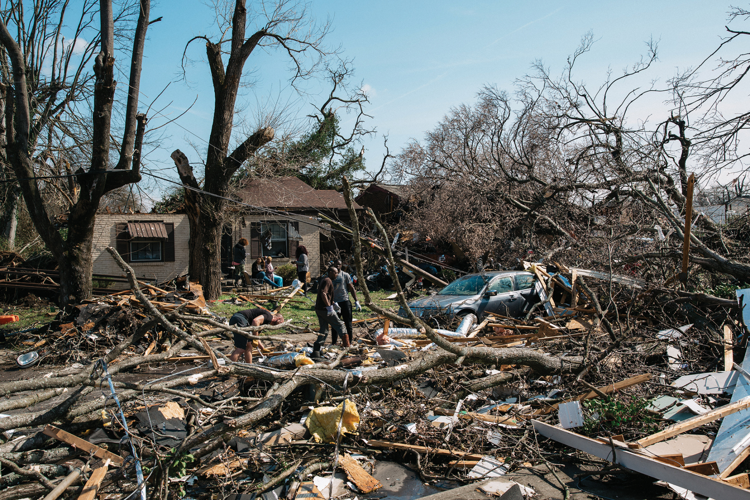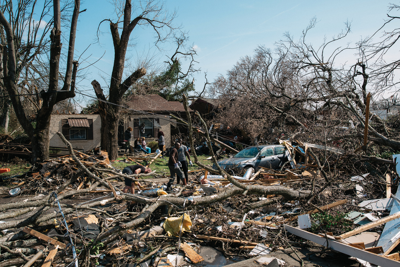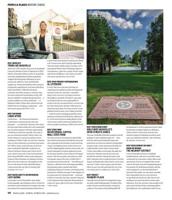
Antionne Gaines inside his North Nashville home
“Years from now, we will be telling our children and grandchildren about this horror and the surviving of it. Maybe, as we tell those stories, we will remember what it was like to see East Nashville, once again, in ruins. If we are truly lucky, we will remember the valiant spirit that plunged in, immediately, to clear the rubble away. We will know that, for all that is gone, there are treasures around us. They have been there all along. There is no wind that can reduce them to dust.”
Those words, written by then-editor Bruce Dobie, appeared in the April 23, 1998, issue of the Nashville Scene, one week after a category-F3 tornado besieged downtown, East Nashville, Donelson and Hermitage. There was one fatality. Dozens of people were injured, and hundreds of houses and businesses were damaged. Large swaths of the city were permanently transformed. But it wasn’t the first time.
Sixty-five years earlier, in March 1933, a tornado — also a category F3 — pummeled downtown, East Nashville and Hermitage, killing 11 Nashvillians.

Theodore Jordan in front of his North Nashville home
Nearly 8,000 days after that 1998 storm — 7,992 days, to be exact — Tennessee’s capital was once again battered by a tornado. And once again, it was an F3 — or an EF3, as it’s known under the since-introduced Enhanced Fujita Tornado Scale. This time, it struck in the dead of night, part of a lethal cluster of cyclones that ripped across the Midstate, ultimately killing 24 people in four counties and effecting colossal damage.
According to the National Weather Service, several supercell thunderstorms spawned the roughly half-dozen tornadoes that wrought chaos in Middle Tennessee in the wee hours of March 3. The one that cut its way across Nashville had the longest path, extending more than 60 miles. The cyclone began at 12:32 a.m. in Pegram, and then carved its deadly path from the western portion of the county near John C. Tune airport — where it did an estimated $93 million in damage — into North Nashville, Germantown, East Nashville, Donelson and Hermitage, before wreaking more havoc in Wilson and Smith counties.
Hundreds of homes and businesses were damaged or destroyed. Multiple buildings at TSU’s agricultural farm in North Nashville were smashed. One of the original brick walls of the 120-year-old Germantown building housing bar and restaurant Geist was toppled. Near East Nashville’s Five Points neighborhood, venues and restaurants including Burger Up, Soda Parlor, The Basement East and High Garden Tea sustained immense damage. (Incredibly, a laminated menu from High Garden was found more than 100 miles away in Overton County.) East Nashville’s East End United Methodist Church took a heavy blow. Much of Donelson Christian Academy was reduced to rubble. At the Old Hickory Boulevard Kroger in Hermitage, vehicles were tossed around the parking lot like Matchbox cars. According to Metro Public Works, 71 traffic signals were damaged or lacking power throughout the city, with 112 roadways initially closed.
Most tragic of all, of course, was the loss of life. At some point shortly before 1 a.m., 36-year-old Michael Dolfini and his 33-year-old partner Albree Sexton were struck by debris while leaving East Nashville bar Attaboy, where Dolfini worked. Sexton, who was employed at East Side establishments Lockeland Table and The Fox, was killed immediately. Dolfini died a short time later.
As the night wore on, more lives were lost, though the total number of deaths and injuries wouldn’t be known for some time.
Just as in 1933 and 1998, the recovery efforts began immediately. Employees at the Bongo Java in Five Points were on site and offering folks coffee by the time the sun was up — for free, even with the shop’s own windows blown out. Volunteers were on the ground throughout the city within hours, with GoFundMe campaigns and fundraisers launched by midweek. Benefit shows were scheduled — and already-booked shows were turned into benefits — at venues including Drkmttr, Exit/In, 3rd and Lindsley, Marathon Music Works and more. Local restaurants and bars began offering shifts to industry professionals whose places of work were out of commission.

Volunteers with Gideon’s Army
In North Nashville, groups like activist organization Gideon’s Army were on the ground and helping with outreach immediately. Third Man Records employees — including Jack White himself — were spotted in uniform and helping with cleanup throughout the neighborhood. Churches like New Covenant Christian Church and Greater Heights Missionary Baptist Church were set up as donation centers, as was nearby art space Elephant Gallery, which also functioned as a charging station for phones. “At first we were running out of stuff like every hour,” says Ellie Caudill, who recently stepped down as Elephant Gallery’s manager, but is still helping with tornado-outreach efforts there. “But now we look like a store.”
Volunteer organization Hands On Nashville began coordinating efforts right away. According to HON, folks had signed up for more than 30,000 volunteer opportunities via the organization’s website by the Friday following the storm. Within 48 hours of the tornadoes, $2.1 million was donated to the Community Foundation of Middle Tennessee; as of press time, that number had grown to $6.5 million. In East Nashville’s Lockeland Springs neighborhood on Saturday, groups of volunteers from across the state could be found clearing brush and passing out meals to fellow volunteers. From donation numbers to the influx of volunteers and resources, the speed and breadth of the response were breathtaking.
Signs of normalcy returned to Shelby Bottoms Sunday as couples lounged in the sunny grass and families crowded the playground. But evidence of the storm’s violence was not far away. Volunteers picked remains of nearby houses out of the woods that surround the greenway, and a gash of downed trees let sunshine through to the previously shady path.
Also on Sunday, Hands On Nashville asked that anyone not already signed up for volunteer opportunities stay home and rest. The response, they noted, was simply too great. As reported by WPLN on Thursday, affected areas including Mount Juliet and Putnam County were also having to turn volunteers away. The Volunteer State was living up to — and indeed, exceeding — its reputation.
State Rep. Bo Mitchell withstood the chaos of the 1998 tornado from Legislative Plaza, where at the time he served as a staffer in the Tennessee Senate. Last week, he could be found in North Nashville and East Nashville, chainsaw in hand, heading in whatever direction help was needed.
“I think it’s simple humanity,” Mitchell tells the Scene, going on to reference the catastrophic flood that hit the city back in 2010. “Whether you’re an elected official or not, I think the flood here in Nashville taught us that. We were a neighborhood and community where I lived in 2010 before the flood. We became a family after the flood. You see the need. You drop what you’re doing if you can and go take care of that need.”
That ethos proves something about our beloved city, and our state. Tennessee’s nickname isn’t simply some outmoded legacy-nod, a dated reference to our propensity for sending volunteers into battle two centuries ago. Volunteerism, giving and community are taken seriously here. No matter what future damage Nashville may withstand — be it on the West Side or the East Side, to the north or to the south — that spirit will never be reduced to dust.
Correction: A previous version of this story stated that there were no fatalities as a result of the 1998 tornado, but that is incorrect. A Vanderbilt student, Kevin Longinotti, was killed in that storm. We regret the error.
Additional reporting by Stephen Elliott.

The paths taken by Nashville's 1933, 1998 and 2020 tornadoes










